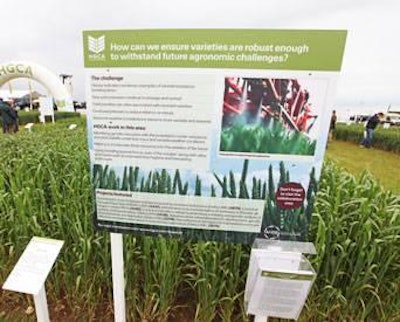
Home Grown Cereals Authority’s research demonstration plots provide an opportunity to discuss the latest technical advances and what they might mean for individual farming businesses. The Home Grown Cereals Authority is part of the United Kingdom’s Agriculture and Horticulture Development Board.
Thirteen areas of research are featured in the plots this year — covering around 30 individual research projects and representing more than $28 million in collaborative investment.
Each area has been designed to promote discussion around a specific question relevant to arable farm businesses and showcases how the Home Grown Cereals Authority is collaborating with other Agriculture and Horticulture Development Board divisions. Questions being posed include:
Which products perform best against diseases of oilseed rape, wheat and barley?
New fungicides continue to be introduced to the UK market and the activity of existing products can change, meaning it can often be difficult to judge which products are the most appropriate for managing diseases. The Home Grown Cereals Authority’s independent fungicide performance trials provide up-to-date information on the activity of key products on the main diseases of oilseed rape, wheat and barley. The work is also looking to identify shifts in the field activity of fungicides as a consequence of changes in the sensitivity of pathogen populations.
Should phosphate be managed differently?
Ensuring crops receive the right levels of nutrients is critical to profitable crop production. Phosphorus is a major nutrient for all crops but global phosphorus resources are finite and can pollute watercourses. The Home Grown Cereals Authority is funding and supporting a range of projects to help growers maximize returns and reduce costs by making the most efficient use of phosphorus fertilizer sources, while also looking to protect water quality. Through the three research projects showcased, the Home Grown Cereals Authority is looking at soil phosphorus levels, phosphorus fertilizers and application techniques, and helping to develop sustainable phosphorus supplies.
What could your oil be used for?
Plant-based lubricants can offer many advantages over mineral oils — they tend to have a lower carbon footprint and, being biodegradable, also have a lower pollution risk. There is a great deal of interest in developing oilseed crops that can meet mineral oil market specifications.
In the UK, oilseed rape is the most obvious crop to focus efforts on, as it is well established in crop rotations. If this market can be tapped, it will open the doors for rapeseed oil to be used in a wide range of new applications — from hydraulic fluids to engine oils. As the European lubricants market is currently worth around 4.5 million metric tons per year — and the demand for biolubricants is growing — Home Grown Cereals Authority is investing in the research to help oilseed rape growers take a share of this potentially lucrative market.
What is an integrated disease management strategy for oilseed rape?
Adapting management strategies to fit local conditions can be a challenge, as the development of the range of soil-borne and foliar diseases in oilseed rape is strongly influenced by weather conditions and previous cropping.
The Home Grown Cereals Authority is investing in a wide range of research to improve understanding of both established and emerging disease threats in oilseed rape to provide growers with the resources to develop integrated strategies for disease management, with an emphasis on targeted and timely control. The research is also helping breeders develop new varieties with robust disease resistance.
Can over 90 percent black-grass control always be achieved?
Continuing reductions in herbicide availability, increasing levels of resistance to acetolactate synthase inhibitor herbicides and difficult weather conditions over the last few autumns have all added to the black-grass management challenge. The Home Grown Cereals Authority research is showing how alternatives to these inhibitors can be combined with cultural options, such as delayed drilling, varying seed rates and weed suppressing varieties, to help growers manage increasing black-grass pressure in arable rotations.
Will aphid-borne virus problems increase?
Aphids can cause significant yield reduction, through transmission of plant viruses and removal of sap, so control of these pests is essential. But due to resistance concerns, close vigilance is essential to safeguard the efficacy of aphicides. Authority-funded research is monitoring the level of resistance in aphids to a range of aphicides. Such information can be used by the industry to plan strategies to help maintain long-term control and by growers to adapt their spray plans based on regional information on aphid activity and resistance status.
Can mycotoxin management be improved?
Certain fungal species can cause fusarium head blight in cereals, which can substantially lower grain yield and quality, as well as produce mycotoxins which can be harmful to humans and animals. The grain quality situation in 2012 highlighted that more needs to be done to fully understand the factors that influence a crop’s ability to meet all-important market specifications.
The Home Grown Cereals Authority is supporting several studies to improve understanding of mycotoxins, along with other contaminants, so that risks can be better managed. The work is investigating the underlying causes of disease infection, producing better models to improve the prediction of mycotoxin production, getting to grips with the genetics of fusarium head blight resistance, providing robust monitoring of grain samples and keeping a close eye on developing risks and changes in mycotoxin legislation.
What is being done to combat Ramularia?
Ramularia leaf spot has become an established barley disease in the north of Europe, being most severe in the wetter parts of the UK. To help combat the threat to both yield and quality in spring and winter barley crops, the authority is investing in work to develop management solutions based on integrated approaches that combine varietal resistance, healthy seed and optimizing fungicide applications.
How can soil productivity be sustained and enhanced?
Soils are an essential foundation for agricultural production which must be managed in order to respond to the current challenges of producing ‘more with less impact’, as well as improving farm profitability. The authority’s collaborative $2.6 million national soil program of research and development, launched at Cereals 2012, is helping soil variability to be better managed, soil structure to be enhanced through manipulating organic matter and the impact of major changes in soil management practices to more ‘sustainable’ systems to be determined.
How can the quality of oats be improved?
Oats are a relatively low-input crop with further potential for the food and feed markets. The authority-funded research is increasing understanding of how genetics, environment and management factors influence milling quality. Knowledge from such pioneering research will be used to help make the oat crop more competitive, both in terms of yield and quality — leading to the inclusion of more oats in cereal-based rotations and reinvigorating the oat market.
Triticale: a more profitable crop than feed wheat?
Recent research has shown that triticale can regularly out-yield wheat and is likely to require fewer inputs, such as nitrogen fertilizers and plant protection products. Some people believe that the triticale crop, which has changed radically in recent years, is a much undervalued crop in the UK. As triticale has potential for the bioethanol feedstock and animal feed markets, the Home Grown Cereals Authority is involved in research that will assist with the further understanding of its performance and help growers determine if triticale is viable for inclusion within their rotations.













